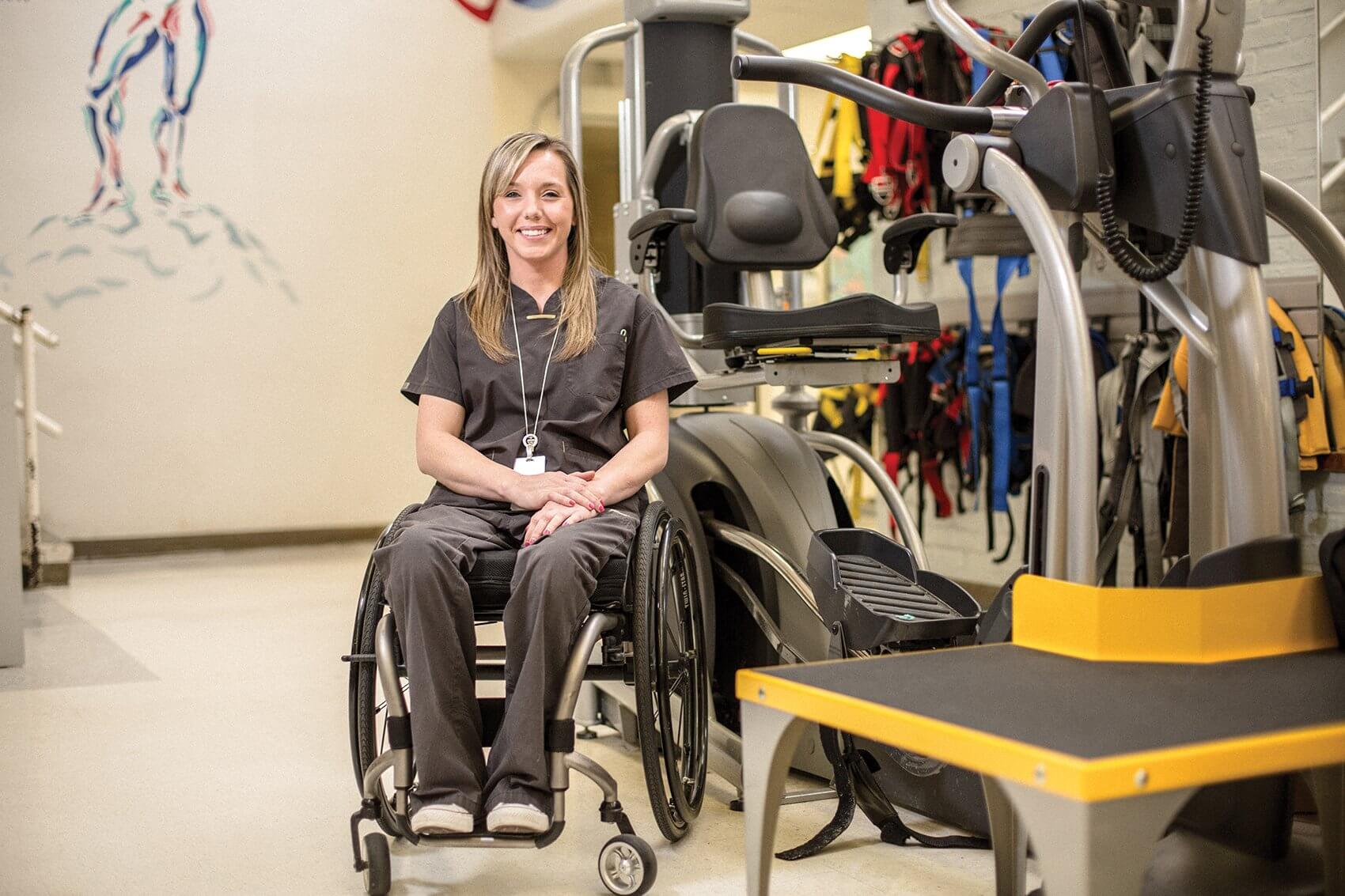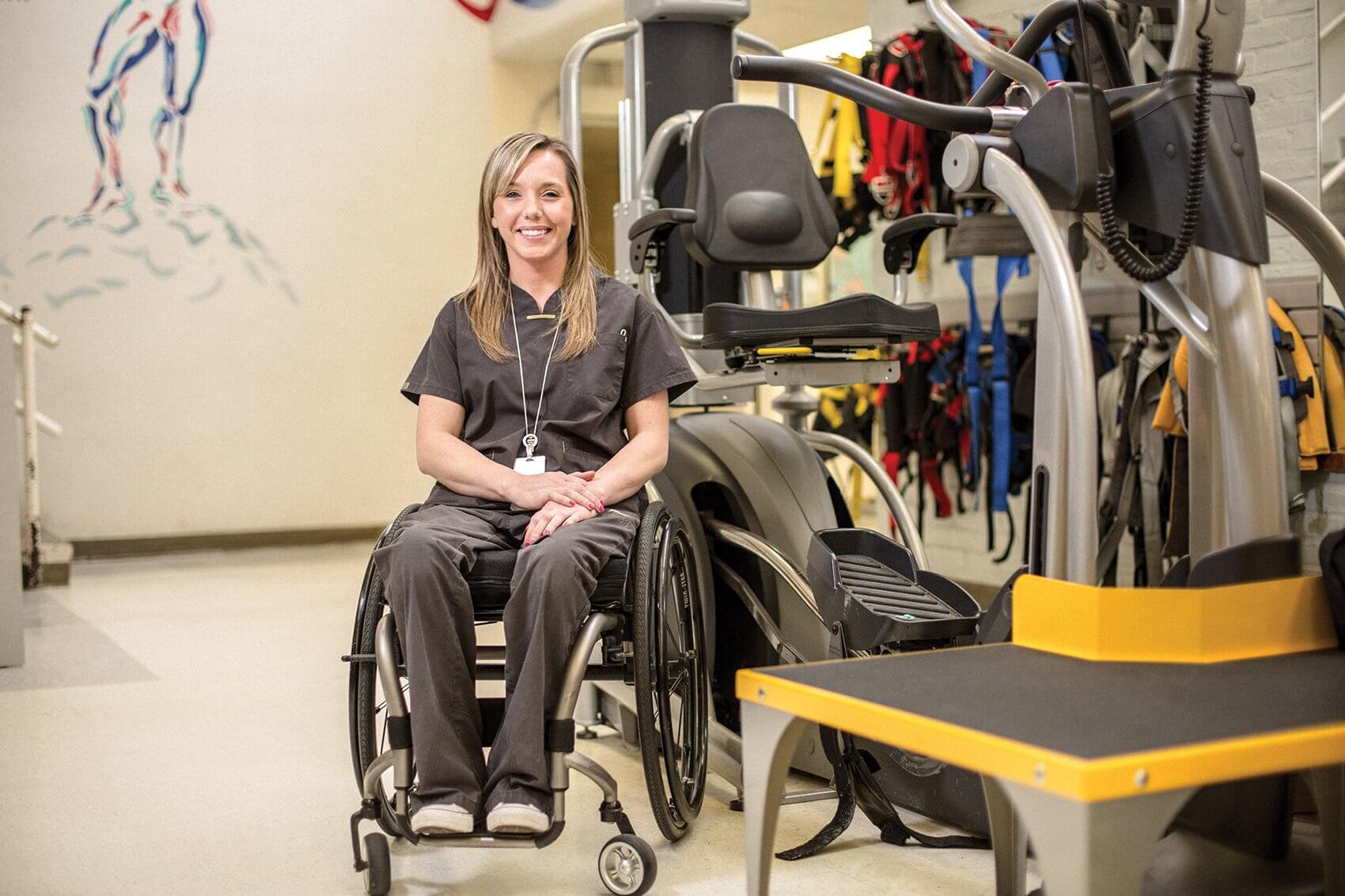Teaching From Experience

On any given day, the rehabilitation gym at TIRR Memorial Hermann is full of light—from the large windows pouring sunlight into the room, to the encouragement offered by TIRR Memorial Hermann’s physical and occupational therapists. Each therapist is a tireless champion for patients, teaching them how full life can be even after a catastrophic injury or illness. But one occupational therapist in particular has intimate knowledge of the ups and downs of rehabilitation—it’s a journey she took just over a decade ago.
In 2002, Emily Potter was in the car with friends. After an evening of letting off steam, shooting fireworks at a friend’s house in the country, the car full of teenagers was speeding down a winding road.
“My friend was driving too fast, we were being young, feeling invincible,” said Potter. “There was a sharp right turn on the old country road and he missed it, lost control of the car, and hit a tree going 80 miles an hour.”
A typical teenage night, the kind that might have been forgotten by the next year, became life altering. Potter ended up with a spinal cord injury that put her in intensive care. She was 19 years old.
“I remember waking up in the ICU thinking, ‘I just got my independence by moving out on my own and starting my life,’” she said. “At that time, I didn’t know whatIwouldbeabletodo.Ididn’tthinkI’dbeableto do anything.”
Soon after Potter arrived at TIRR Memorial Hermann for rehab, however, she learned her initial fears about how deeply her injury would impact her life were unfounded. Her future looked different, but it would still be fulfilling and independent.
“When I started the rehab experience here at TIRR, it became clear very quickly that there is life after a life-changing event,” said Potter. “The feeling of being here was, ‘You’re part of the family. We’re going to come alongside you and we’re going to help you and your family move down the road and get you to the highest level of independence possible.’ That attitude and that motivation they gave me inspired me.”
Potter’s own rehab experience put her on a completely different career path. Prior to her accident, she had two possible vocations in mind. On one hand, she was interested in teaching. On the other, she had volunteered at a hospital and was considering nursing or physical therapy. During rehab, Potter became acquainted with occupational therapy and realized
it was a perfect match.
“Occupational therapy was a good mix of getting people strong enough to participate in everyday life activities and education, and a light bulb went off: this is what I need to do,” she said. “I went back to school and came back here for an internship. I fell in love during my internship and I’ve been here ever since.”
As an occupational therapist, Potter’s first priority is helping her patients make a plan to get back out into the community and regain their independence. That begins with learning how to do everyday activities—grooming, dressing and bathing—in a new way. These are things all occupational therapists teach, but as someone who uses a wheelchair, Potter offers her patients a different perspective.
“I can show them, ‘We might not have the same injury, but I can relate to you because I use a wheelchair every day, so let me show you how I dress myself,’” she said. “I may demo with some large pants and show them how I do it. I say, ‘You may not be able to do it just like me, but maybe you will down the road.’”
In addition to practical demonstrations, Potter said she hopes her patients will be able to initiate tough conversations they are not comfortable having with anyone else, knowing she has personal experience.
“I feel that I can get away with saying some things to them at times, like, ‘Hey, we’ve got to get you to this next level. I’ve been there, I know how hard it is, but let me give you some advice,’” she said. “I think sometimes they listen to me on that level and I can help them a little more in some ways that maybe someone else may not be able to.”
TIRR Memorial Hermann patient Michael Bullitt knows the value of Potter’s motivation firsthand.
“It’s a lot easier to have someone who’s been there and experienced what I’ve experienced,” said Bullitt, a couple months into treatment. “You don’t want to say ‘can’t’ around here, because they’re going to make it to where you can. I’ve progressed more here than I ever thought possible.”
Six years took Potter from patient to therapist. Getting to where she is today was not always easy, and Potter admits to struggling at times. She encourages her patients to seek out a therapist to talk through any emotional issues, something she did at the beginning.
“I had a phase of two years where I felt sorry for myself and got a little bit depressed,” said Potter. “I believe in tough love, and I had to have some tough love myself, to say, ‘You have got to get yourself moving.’ Once I did that, I did better. The picture of where you are now is not what it’s going to look like in a week, two months, a year.”
That tough love is something she shares with her patients. The first task after injury, getting up out of the bed, is often the hardest, Potter said, but it leads to bigger and better things. You might be moving differently, but you’re still moving forward. Using a wheelchair will change your life, but it doesn’t define it.
“I knew I wanted to do something with my life and I knew I wanted to give back, but I don’t think I ever could have imagined I’d be as fulfilled by my job and life in general.” said Potter. “Get up out of the bed, get in a chair and do something. Then you build momentum and all of a sudden, you’re out living your life.”





